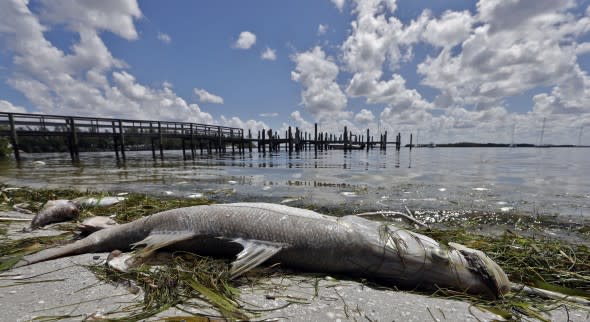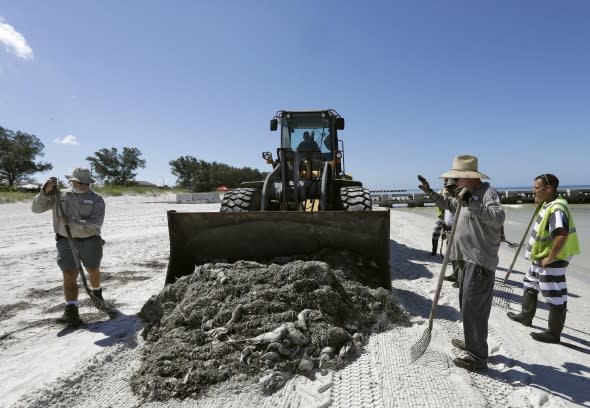Florida governor declares state of emergency to combat worst red tide in over 10 years
Florida Gov. Rick Scott issued a state of emergency due to impacts of red tide on Monday, Aug. 13.
The state of emergency covers Collier, Lee, Charlotte, Sarasota, Manatee, Hillsborough and Pinellas counties.
Red tide is a naturally occurring algae that has been documented along Florida's Gulf Coast since the 1840s and occurs nearly every year, according to the press release.

A dead Snook is shown along the water's edge in Bradenton Beach, Florida, on Monday Aug. 6, 2018. From Naples in Southwest Florida, about 135 miles north, beach communities along the Gulf coast have been plagued with red tide. (AP Photo/Chris O'Meara)
"As Southwest Florida and the Tampa Bay area continues to feel the devastating impacts of red tide, we will continue taking an aggressive approach by using all available resources to help our local communities," Scott said in the press release. "Today, I am issuing an emergency declaration to provide significant funding and resources to the communities experiencing red tide so we can combat its terrible impacts."
The resources include making additional FWC biologists and scientists available to assist in clean-up and animal rescue efforts, more than $100,000 for Mote Marine Laboratory and $500,000 for Visit Florida to establish an emergency grant program.
The Visit Florida emergency grant program is to help local communities continue to bring in the visitors that support so many Florida families and businesses.
Scott is also directing a further $900,000 in grants for Lee County to clean up impacts related to red tide, bringing the total red tide grant funding for Lee County to more than $1.3 million.
The algae bloom is considered to be the longest red tide outbreak for the Gulf of Mexico in over a decade, and officials say it will most likely last until 2019.
High concentrations of toxic algae, known as blooms, have affected at least 120 miles of the peninsula's Gulf of Mexico coast since November 2017.
Officials say nearly 300 sea turtles have died because of the toxic bloom. Other sea life, such as pelicans, manatees and a whale shark, have washed ashore since this unprecedented bloom started.
"While we fight to learn more about this naturally occurring phenomenon, we will continue to deploy all state resources and do everything possible to make sure that Gulf Coast residents are safe and area businesses can recover," Scott said.

Work crew clean up dead fish on Coquina Beach in Bradenton Beach, Florida, on Monday Aug. 6, 2018. Normally crystal clear water is murky, and the smell of dead fish permeates the air (AP Photo/Chris O'Meara)
"At Gov. Rick Scott's direction, the Florida Fish and Wildlife Conservation Commission (FWC) has mobilized all available resources to mitigate naturally occurring red tide, and executive director Eric Sutton has waived rules through an executive order to expedite the removal of dead fish," a FWC press release reads.
FWC research teams are assessing the impacts of the fish killed as a result of this event. Their findings could help to inform potential management actions.
"Having lived in South Florida for many years, I know how impactful these naturally occurring red tide events can be to local communities," said Eric Sutton, executive director of the FWC, said in the release. "We are actively working with local authorities in the most impacted areas and stand ready to provide assistance to local communities."
Fish populations have been resilient to the impact of red tide, even after severe and prolonged red tide events.
